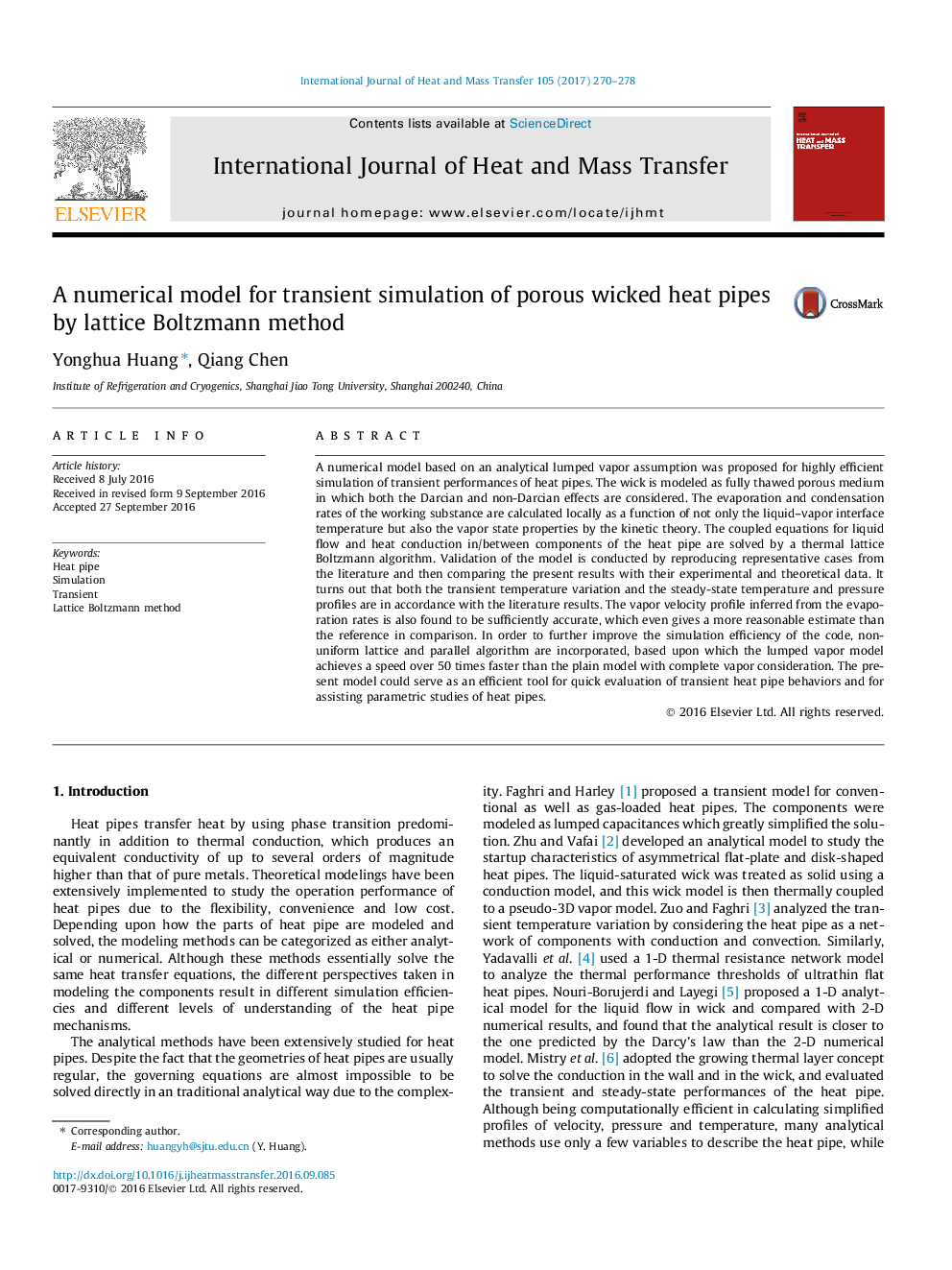| کد مقاله | کد نشریه | سال انتشار | مقاله انگلیسی | نسخه تمام متن |
|---|---|---|---|---|
| 4994690 | 1458037 | 2017 | 9 صفحه PDF | دانلود رایگان |
عنوان انگلیسی مقاله ISI
A numerical model for transient simulation of porous wicked heat pipes by lattice Boltzmann method
ترجمه فارسی عنوان
یک مدل عددی برای شبیه سازی گذرا از لوله های گرما متخلخل با روش شبکه بولتزمن
دانلود مقاله + سفارش ترجمه
دانلود مقاله ISI انگلیسی
رایگان برای ایرانیان
کلمات کلیدی
ترجمه چکیده
یک مدل عددی بر پایه فرضیه بخار بر پایه تحلیلی برای شبیه سازی کارایی گذرا از لوله های گرما پیشنهاد شد. مارپیچ به عنوان محفظه متخلخل به طور کامل خنثی شده است که در آن هر دو اثرات دارچین و غیر دارچین در نظر گرفته می شود. نرخ تبخیر و تراکم مواد کار می کند به صورت محلی به عنوان عملکرد نه تنها دمای مایع بخار مایع، بلکه همچنین خواص حالت بخار به وسیله نظریه جنبشی محاسبه می شود. معادلات مربوط به جریان مایع و هدایت گرما در / بین مولفه های لوله گرما با الگوریتم بولتزمن با استفاده از شبکه حرارتی حل می شود. اعتبار این مدل با بازتولید موارد نمایه از ادبیات و سپس مقایسه نتایج کنونی با داده های تجربی و نظری آنها انجام می شود. به نظر می رسد که تغییرات دمای گذرا و شرایط دمایی و فشار پایدار مطابق با نتایج ادبیات است. پروفیل سرعت بخار از میزان تبخیر ناشی از میزان تبخیر نیز مشخص شده است که به اندازه کافی دقیق است، که حتی برآورد مناسبتری نسبت به مرجع در مقایسه دارد. به منظور بهبود کارایی شبیه سازی کد، الگوریتم شبکه غیرموضعی و الگوریتم موازی گنجانده شده است، بر اساس آن مدل بخار توده ای با سرعت بیش از 50 برابر سریعتر از مدل ساده و با توجه به بخار کامل، به دست می آید. مدل حاضر می تواند به عنوان یک ابزار کارآمد برای ارزیابی سریع رفتار رفتار لوله های گذرا و کمک به مطالعات پارامتری لوله های حرارتی باشد.
موضوعات مرتبط
مهندسی و علوم پایه
مهندسی شیمی
جریان سیال و فرایندهای انتقال
چکیده انگلیسی
A numerical model based on an analytical lumped vapor assumption was proposed for highly efficient simulation of transient performances of heat pipes. The wick is modeled as fully thawed porous medium in which both the Darcian and non-Darcian effects are considered. The evaporation and condensation rates of the working substance are calculated locally as a function of not only the liquid-vapor interface temperature but also the vapor state properties by the kinetic theory. The coupled equations for liquid flow and heat conduction in/between components of the heat pipe are solved by a thermal lattice Boltzmann algorithm. Validation of the model is conducted by reproducing representative cases from the literature and then comparing the present results with their experimental and theoretical data. It turns out that both the transient temperature variation and the steady-state temperature and pressure profiles are in accordance with the literature results. The vapor velocity profile inferred from the evaporation rates is also found to be sufficiently accurate, which even gives a more reasonable estimate than the reference in comparison. In order to further improve the simulation efficiency of the code, non-uniform lattice and parallel algorithm are incorporated, based upon which the lumped vapor model achieves a speed over 50 times faster than the plain model with complete vapor consideration. The present model could serve as an efficient tool for quick evaluation of transient heat pipe behaviors and for assisting parametric studies of heat pipes.
ناشر
Database: Elsevier - ScienceDirect (ساینس دایرکت)
Journal: International Journal of Heat and Mass Transfer - Volume 105, February 2017, Pages 270-278
Journal: International Journal of Heat and Mass Transfer - Volume 105, February 2017, Pages 270-278
نویسندگان
Yonghua Huang, Qiang Chen,
